
We use Pn phase travel time residuals to invert for mantle lid velocity and anisotropy beneath northern Arabia eastern Anatolia continent-continent collision zone. The primary phase data were obtained from the temporary 29- station broadband PASSCAL array of the Eastern Turkey Seismic Experiment. These data were supplemented by phase data from available stations of the Turkish National Seismic Network, the Syrian National Seismic Network, the Iranian Long Period Array, and other stations around the southern Caspian Sea. In addition, we used carefully selected catalog data from the International Seismological Centre and the National Earthquake Information Center bulletins. Our results show that low (<8 km/s) to very low (<7.8 km/s) Pn velocity zones underlie the Anatolian plateau, the Caucasus, and northwestern Iran. Such low velocities are used to infer the presence of partially molten to absent mantle lid beneath these regions. In contrast, we observed a high Pn velocity zone beneath northern Arabia directly south of the Bitlis-Zagros suture indicating the presence of a stable Arabian mantle lid. This sharp velocity contrast across the suture zone suggests that Arabia is not underthrusting beneath the Anatolian plateau and that the surface suture extends down to the uppermost mantle. Pn anisotropy orientations within a single plate (e.g. Anatolia plate) show a higher degree of lateral variation compared to Pn velocity. Areas of coherent Pn anisotropy orientations are observed to continue across major fault zones such as the EAF zone.
Click here to view a PDF of the post-print
An edited version of this paper was published by AGU. © 2003 American Geophysical Union.
Figure 3. (a) A map showing our tomographic image of Pn velocity using only the data picked and read by the authors. The upper bounds of high Pn velocity zone along the EAF and the eastern BS are used to define the northern extent of the Arabian plate boundary. (b) A map showing 1.5° x 1.5° checkerboard test results inverted using the same stations and events distribution for Figure 3a. The best resolution is along the EAF, eastern BS zones, and at the intersection zone between the EAF and NAF zones. Symbols are as in Figure 2 (see reference).
